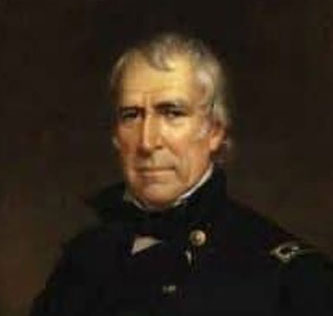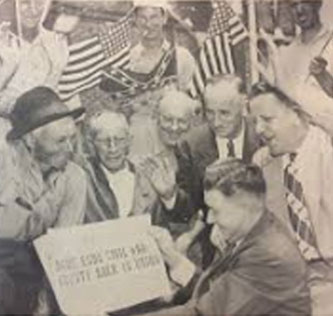Dade County was established in 1837 and named for Major Francis Langhorne Dade, who was killed in the Dade Massacre by Seminole Indians in December 1835. The original population of Dade County was composed of an indigenous band of Cherokee, led by Chief Wauhatchie, who were forcibly removed from the land in 1838 during the Trail of Tears. Dade County’s first settlers won the land in Georgia’s land lottery and came to work in coke and coal mines.
Folklore has it that Rising Fawn was named by an Indian chief whose tribe made their home in the foothills of Lookout Mountain. He wanted to give his beautiful daughter the perfect name. One morning he spotted a fawn rising out of the brush in a nearby field. As he observed the large eyes and gracefulness of the body, he knew he had found the name for his daughter – “Rising Fawn” – which became the name of the settlement there.
Wildwood is in the northern part of Dade County. It is home to the noted Southern humorist George Washington Harris (1814–1869) and Harris is buried in the Brock Cemetery in Wildwood, GA. He was considered one of the semi- nal writers of Southern humor and greatly influenced the literary works of Mark Twain, William Faulkner, and Flannery O'Connor. Across the street from Brock Cemetery in Wildwood is Belvedere Plantation c. 1835, the oldest of the few remaining antebellum homes in the area.
New England, Georgia was named as such because nearby iron ore deposits were hoped to attract northern capital to the area. A “city” was surveyed, plotted, and mapped, and lots were sold at auction. Northern business interests, how- ever, did not continue. Community members returned to making their living in agriculture.

Georgia’s Lost County
For years after its creation, the sparsely populated county had virtually no development. Dade was known as the “Lost County” of Georgia as the people had no way of getting to other places in the state except by going through Tennessee via Chattanooga, through Alabama via Mentone, or by crossing Lookout Mountain on foot or horseback. The Legislature of 1849 made an appropriation of $3,500 to build a road over Lookout Mountain, but the road was not built until nearly 100 years later, in 1947-48. Highway 143 (now Highway 136) connected U.S. 41 to the area, and the county was subsequently discovered by tourists with the creation of Cloudland Canyon State Park.


The Independent State of Dade
In May 1860, the Georgia General Assembly was locked in debate at the State Capital in Milledgeville over the question of Georgia’s secession from the Union. Up from his seat in the back of the Senate rose a representative from Dade County by the name of Robert H. Tatum. “Uncle Bob,” as he was fondly called, gained the floor and shouted out the fiery speech which has become both legend and lore. “By the gods, gentlemen,” the old man said, “if Georgia doesn’t vote to immediately secede from the Union, Dade County will secede from Georgia and become The Independent State of Dade!” A few days later, when Georgia still had not seceded from the Union, Tatum made good on his promise. He hurriedly left the Capital and by train, buggy, and then horseback, came to the village of Trenton where he called for a public meeting. The people gathered on the courthouse square. Bob Tatum stepped up and told the crowd of endless debates going on at the Capital. A vote was taken that day and led by Bob Tatum, Dade County seceded from Georgia.
After the Civil War, no written document ever announced the return of Dade County to the Union. Eighty-five years later, a group directed by Judge J.M.C. Townsend decided to stage a celebration whereby the “State of Dade” would rejoin the Union. About 4,000 citizens came in from the hills on July 4, 1945, to vote for and celebrate the event. The pageant, “The Return of Dade County,” was broadcast from the Dade County Courthouse at Trenton by Radio Station WAGA in Atlanta. Judge Townsend’s speech was broadcast over a coast-to-coast hookup of the American Broadcast Company. Paramount Pictures cameramen were on hand to record the event over the 12-station southern network. And a telegram from President Harry S. Truman was read to mark the occasion.
The following excerpt is from Judge Townsend’s speech: “Now let us consider a resolution that the Free State of Dade shall cease to exist, and that Dade County shall return in spirit and in fact to the Sovereignty of the State of Georgia.” Those in favor signified with an unbridled bedlam of “Ayes.” And so, on July 4, 1945, the Stars and Stripes officially flew over the “Free State of Dade” for the first time since the beginning of the Civil War.
Shortly after the Georgia State Quarter was released in July 1999, Dade County gained attention over an apparent mistake in the quarter. The outline of Georgia on the quarter appears to have accidentally left out Dade County, which is in the extreme northwestern part of the state. Some have suggested that the exclusion was intentional, in reference to the legend of Dade County’s secession from Georgia!

Arts and Artists
The Plum Nelly Clothesline Art Show started in the late 1940s, exhibiting works by artists Fannie Mennen, Virginia Dudley, and Frank Baisden. As more and more artists moved to studios in the Rising Fawn area, they welcomed other talented artists to visit and exhibit, including Esther Rolick, one of the few female avant-garde painters who still has works in major galleries and papers that are in the Smithsonian.
Thousands of visitors came each year to see the works of artists and crafters. The Plum Nelly Clothesline Art Show flourished for 26 years, morphing into today’s New Salem Mountain Festival.
The New Salem Mountain Festival is held atop Lookout Mountain on the second Saturday and Sunday of October. Today, in addition to The New Salem Mountain Festival, the community is known for it’s Plum Nelly Art Show held in Trenton the second Saturday in August and the Rising Fawn Studio Tour held atop Lookout Mountain on the second Saturday and Sunday in December.
Dade County has also produced some prominent musical artists. American stringed instrument and Nashville studio artist and songwriter Norman Blake, best known for his music for the film O Brother, Where Art Thou!, started his performance career at venues around Dade County. He has been inducted in the Bluegrass Hall of Fame in Owensboro, Kentucky.
American country music vocal group and three-time Grammy Award nominees The Forester Sisters started performing locally in their native Lookout Mountain before heading to Nashville and, in the 1990s, charting 15 top-ten hits on the Billboard Hot Country Songs chart, five of which went to number one.
Got a Question?
Alliance for Dade・Chamber of Commerce & Welcome Center
Located in Dade County Historic Courthouse
12345 Main Street ・ P.O. Box 222
Trenton, Georgia 30752
706.657.4488


